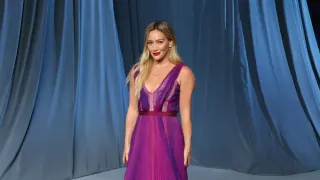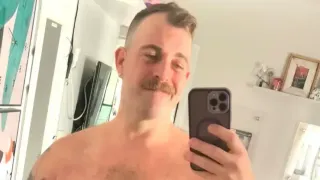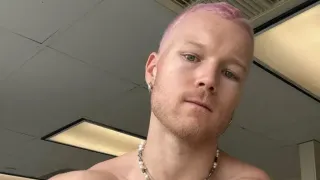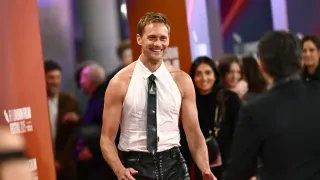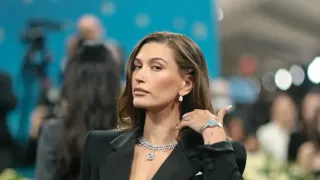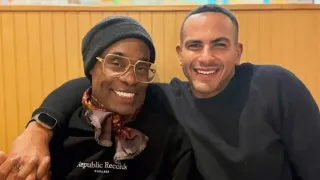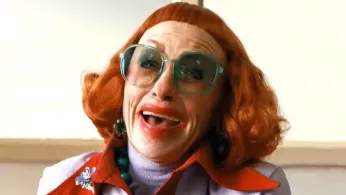
6 hours ago
Aunt Gladys Rises: How a Horror Villain Became a Halloween and Drag Sensation
READ TIME: 4 MIN.
When "Weapons," the suburban horror film from writer/director Zach Cregger, hit theaters earlier this year, it quickly became one of the year’s biggest box office successes and a critical darling. At the center of its terrifying plot is Aunt Gladys, a witchy, eccentric figure played with unforgettable panache by Amy Madigan. Gladys is responsible for the film’s central mystery—the disappearance of 17 children from a single third-grade class—and her over-the-top aesthetic, complete with a shocking red wig, heavy makeup, bold sunglasses, and colorful, mismatched outfits, immediately set her apart from more traditional horror antagonists .
The character’s visual identity was a collaborative effort: special makeup effects designer Jason Collins, makeup department head Leo Satkovich, and hair department head Melizah Anguiano Wheat brought Gladys to life, crafting a look that is both creepy and irresistibly campy . According to Wheat, the team never anticipated that Gladys would become such a sensation, but as fan art, cosplay, and even a custom Monster High doll began to surface, it became clear that something special was happening .
As Halloween approaches, Aunt Gladys is poised to be one of the most popular costumes of the season. Her look is both instantly recognizable and easy to replicate, with key elements—red wig, baby bangs, oversized glasses, and garish makeup—readily available at costume shops or online retailers . Director Zach Cregger has expressed excitement at the prospect of seeing “waves of colorful witches” at parties and parades, even though he’ll be out of the country filming during the holiday .
But it’s not just about faithful recreations. The character’s inherent campiness has inspired a wave of creative reinterpretations, including the inevitable “Sexy Aunt Gladys” variants. Cregger himself has encouraged fans to take creative license, telling CinemaBlend, “Bring it on. It’s all, it’s all legal. Let’s go” . This openness to fan expression has further fueled Gladys’s popularity, making her a versatile muse for Halloween enthusiasts of all ages and backgrounds.
Perhaps the most surprising and significant development in Gladys’s rise has been her adoption by the drag community. Drag performers, always attuned to the power of camp and the allure of the villainess, have embraced Gladys with particular enthusiasm. Leo Satkovich, the film’s makeup department head, recalls the moment he realized Gladys had “made it”: drag queen Morgan McMichaels performed as the character just days after the film’s release, complete with baby bangs, smeared lipstick, and giant glasses—a tribute that went viral in LGBTQ+ circles .
Since then, “Night of 1000 Gladyses” events have popped up at gay bars around the world, with queens putting their own spin on the character. Satkovich describes the experience as “surreal,” noting that he tries to share every flyer he sees for these events. “It’s definitely wild. I can’t believe she’s been embraced so much by our community, but it’s really cool,” he told Out .
The creative team behind Gladys’s look encourages anyone attempting the character—whether for Halloween or drag—to “go big, go bold,” and not be afraid to put their own stamp on her. “Take that bang a little shorter. Draw that eyebrow on a little wonkier. Just have fun with it,” Satkovich advises. Jason Collins adds, “Get that wig higher than you think you need to to expose the forehead,” while Wheat suggests making the look “a little crooked” and, most importantly, “take lots of pictures” .
This DIY, creative spirit is a hallmark of both Halloween culture and drag, and Gladys’s malleability as a character—part witch, part suburban menace, part camp icon—makes her a perfect fit for both.
Aunt Gladys’s journey from horror villain to Halloween and drag icon is more than a passing trend; it reflects broader shifts in how pop culture is consumed and reinterpreted by diverse communities. For many in the LGBTQ+ community, especially drag performers and fans, embracing a character like Gladys is a celebration of outsider status, camp aesthetics, and the power of transformation. Her over-the-top look and mysterious, menacing persona offer a canvas for self-expression that resonates with queer audiences who have long found kinship with misunderstood or monstrous figures.
The character’s creators have expressed humility and joy at seeing her embraced so fully. Collins, who designed her makeup, initially saw Gladys as simply “creepy,” but now recognizes that her appeal lies in her uniqueness and the freedom she offers for reinterpretation. “Anytime you can have an impact on anybody watching something, let alone people that want to dress up as them or be them or know their motivations or see more to the story, that just means we’ve all done our job to the max that we could. And it’s really inspiring, seeing that sort of take off and people’s interpretation of what you’ve done,” he told Out .
While Gladys’s look and persona have made her a Halloween and drag sensation, her backstory adds another layer of intrigue. Director Zach Cregger has revealed that Gladys is more than a stock villain—she represents deeper themes, including alcoholism and personal trauma, drawing on autobiographical elements from his own childhood . This complexity, though not fully explored in the film itself, adds weight to her character and may contribute to her enduring appeal. Fans and performers are not just drawn to her aesthetic, but to the mystery and potential for storytelling that she embodies.
As Halloween approaches, Gladys’s presence in pop culture shows no signs of slowing down. Her image is proliferating across social media, with fans sharing their costumes, drag queens posting performance videos, and artists creating new interpretations. The character’s team continues to engage with this outpouring of creativity, sharing fan works and celebrating the community that has formed around her.
For many, Gladys represents the best of what modern horror can offer: a character who is scary, funny, glamorous, and deeply human all at once. Her rise as a Halloween and drag icon is a testament to the power of inclusive, campy storytelling—and a reminder that the most memorable monsters are often the ones who inspire us to embrace our own weirdness.
